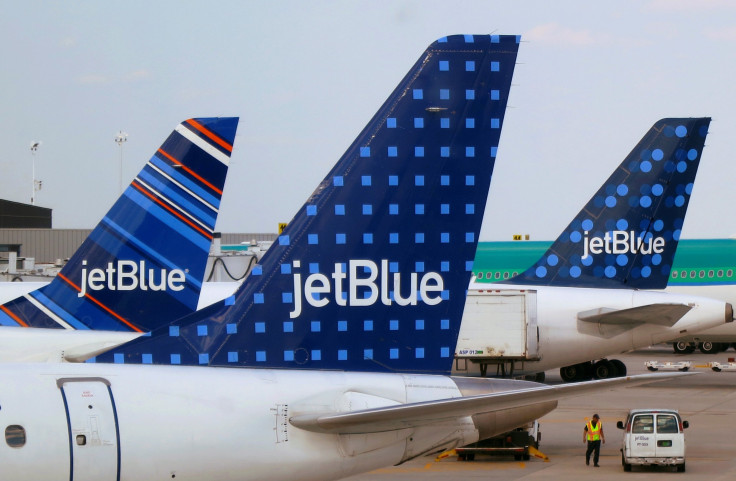JetBlue Is Canceling More Routes

Last year, JetBlue Airways (NASDAQ:JBLU) set an ambitious target of nearly doubling its earnings per share to a range of $2.50 to $3.00 by 2020.
A key piece of the strategy that management laid out was a plan to reallocate capacity from routes with low relevance to the airline's network to its best markets. Rather than looking beyond JetBlue's six focus cities for growth, the carrier wants to add more capacity to high-performing routes -- and to a lesser extent, add new routes from its biggest focus cities.
JetBlue had already begun implementing changes before its investor day last October. But the adjustments have accelerated in 2019. Just last week, JetBlue rolled out more changes to its route network that will see it drop another set of noncore routes in favor of increased service in busy markets where JetBlue already has a strong position.
Changes in Washington, D.C., began last year
Some of JetBlue's biggest route network changes have come in the Washington, D.C., area. As recently as 2010, JetBlue didn't have slots to fly to Reagan National Airport, the closest airport to downtown Washington, D.C. -- and also the city's most popular airport. All of its flights instead went to the more-distant Dulles International Airport.
In a series of deals between 2010 and 2014, mainly with American Airlines(NASDAQ:AAL), JetBlue managed to acquire approximately 30 slot pairs at Reagan Airport. (Each slot pair allows one takeoff and one departure.)
JetBlue acquired its biggest batch of slot pairs in 2014, when American Airlines was forced to sell slots to secure regulatory approval for its merger with US Airways. JetBlue used most of the slots to launch new service from Reagan Airport to Charleston, South Carolina; Fort Myers, Florida; Hartford, Connecticut; Jacksonville, Florida; Nassau, Bahamas; and West Palm Beach, Florida. Around that time, the carrier dropped its long-haul routes at Dulles Airport but continued to fly from that airport to its New York and Boston focus cities.
Shortly after its investor day last year, JetBlue announced that it would pull out of Dulles Airport in early 2019. This means it no longer flies between New York and Washington, D.C. -- but that's a market where it's tough to compete with Amtrak, not to mention the high-frequency service offered by American Airlines and Delta Air Lines.
More recently, JetBlue announced in late February that it would end its flights from Reagan Airport to Hartford and Tampa in early July. That move cleared the way for additional flights between Boston and D.C., a strategically vital (and highly lucrative) route for JetBlue.
The Washington, D.C., strategy shift continues
Last week, JetBlue announced that it will eliminate two more routes at Reagan National Airport. The carrier's flights to Charleston and Jacksonville will end on Oct. 26. With those route cancellations, JetBlue will have reversed most of its 2014 expansion at Reagan Airport. It will use the four slot pairs freed up for additional daily flights on its routes to Boston, Fort Lauderdale, Fort Myers, and West Palm Beach.
After these changes, JetBlue will offer near-hourly "shuttle" service between Boston and Reagan Airport, with up to 15 daily flights. It will also fly four times a day to Orlando and six times a day to Fort Lauderdale. The rest of its slots will support flights once or twice a day to various leisure markets, mainly in Florida or the Caribbean.
Clearly, JetBlue has realized that it can't make money on low-demand routes at Reagan Airport, even if they are underserved. American Airlines has a dominant position at the airport, with more than 250 slot pairs. That makes it the go-to option for business travelers. American also offers more frequent service than JetBlue on all of the routes the latter is cutting, making it a more convenient option for many leisure travelers.
JetBlue is pulling out of other noncore markets, too
The elimination of noncore routes extends beyond Washington, D.C. JetBlue has decided to exit the Anchorage, Alaska, market, terminating its seasonal flights from Seattle and Portland at the end of the summer. JetBlue has a small presence in all of those cities, so those flights had minimal strategic importance to the airline. (If demand warrants, it would make more sense to offer nonstop seasonal service from Boston or New York to Anchorage in the future.)
JetBlue will also scrap its twice-daily service between New York and Charlotte this fall, instead increasing from three to five daily roundtrips on its Boston-Charlotte route. Charlotte is mainly a business market, and JetBlue has a far bigger base of business customers in Boston.
Finally, JetBlue will stop flying from New York to La Romana, Dominican Republic, in early 2020. The carrier still serves four other (more popular) destinations in the Dominican Republic from New York.
JetBlue's decision to drop out of noncore markets where it mainly competed on price could lead to higher fares for travelers. But it's almost certainly a good decision for the airline. JetBlue has its greatest competitive advantage in cities where it has high market share -- primarily Boston, but also Fort Lauderdale, New York, and Orlando. Reallocating capacity to those cities from places where it has low market share should help power strong earnings growth over the next year or so.
This article originally appeared in the Motley Fool.
Adam Levine-Weinberg owns shares of Delta Air Lines and JetBlue Airways and is long January 2020 $20 calls on American Airlines Group. The Motley Fool owns shares of and recommends Delta Air Lines. The Motley Fool recommends JetBlue Airways. The Motley Fool has a disclosure policy.





















